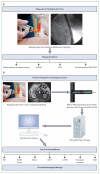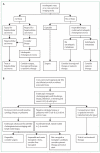Cholangiocarcinoma
- PMID: 24581682
- PMCID: PMC4069226
- DOI: 10.1016/S0140-6736(13)61903-0
Cholangiocarcinoma
Abstract
Cholangiocarcinoma represents a diverse group of epithelial cancers united by late diagnosis and poor outcomes. Specific diagnostic and therapeutic approaches are undertaken for cholangiocarcinomas of different anatomical locations (intrahepatic, perihilar, and distal). Mixed hepatocellular cholangiocarcinomas have emerged as a distinct subtype of primary liver cancer. Clinicians need to be aware of intrahepatic cholangiocarcinomas arising in cirrhosis and properly assess liver masses in this setting for cholangiocarcinoma. Management of biliary obstruction is obligatory in perihilar cholangiocarcinoma, and advanced cytological tests such as fluorescence in-situ hybridisation for aneusomy are helpful in the diagnosis. Liver transplantation is a curative option for selected patients with perihilar but not with intrahepatic or distal cholangiocarcinoma. International efforts of clinicians and scientists are helping to identify the genetic drivers of cholangiocarcinoma progression, which will unveil early diagnostic markers and direct development of individualised therapies.
Copyright © 2014 Elsevier Ltd. All rights reserved.
Figures




Comment in
-
Liver transplantation for intrahepatic cholangiocarcinoma--Authors' reply.Lancet. 2014 Sep 27;384(9949):1182-3. doi: 10.1016/S0140-6736(14)61717-7. Lancet. 2014. PMID: 25263671 No abstract available.
-
Liver transplantation for intrahepatic cholangiocarcinoma.Lancet. 2014 Sep 27;384(9949):1182. doi: 10.1016/S0140-6736(14)61716-5. Lancet. 2014. PMID: 25263672 No abstract available.
References
-
- Razumilava N, Gores GJ. Combination of gemcitabine and cisplatin for biliary tract cancer: a platform to build on. J Hepatol. 2011;54:577–78. - PubMed
-
- Komuta M, Govaere O, Vandecaveye V, et al. Histological diversity in cholangiocellular carcinoma reflects the different cholangiocyte phenotypes. Hepatology. 2012;55:1876–88. - PubMed
Publication types
MeSH terms
Grants and funding
LinkOut - more resources
Full Text Sources
Other Literature Sources
Medical

